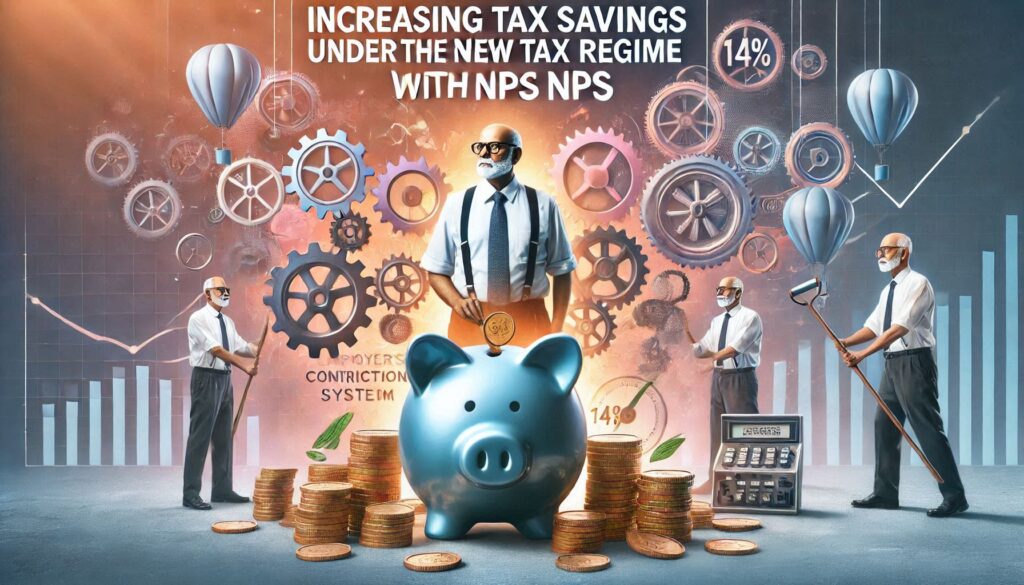Increasing Tax Savings Under the New Tax Regime with NPS

The new tax regime introduced in the Budget 2024 offers significant tax savings opportunities for salaried individuals, particularly through the National Pension System (NPS). The government has increased the employer’s contribution limit to 14% for those opting for the new tax structure. Here we outlines the implications of these changes, the potential benefits for various income brackets, and considerations for maximizing tax savings through the NPS.
Key Points
- Enhanced Employer Contribution: The new tax regime allows employers to contribute up to 14% of an employee’s basic salary to their NPS accounts, compared to the previous limit of 10% under the old tax regime.
- Tax Deductions: Employees can claim deductions on their own NPS contributions up to 10% of their basic salary under Section 80CCE, with an additional allowance of Rs 50,000 under Section 80CCD(1B) if they opt for the old regime.
- Income Bracket Analysis: The tax benefits of opting for the new regime versus the old regime depend significantly on an individual’s income level and the total deductions claimed.
- High-Income Considerations: Higher earners must navigate the Rs 7.5 lakh cap on total employer contributions to avoid tax implications on excess amounts.
- Retirement Planning: While NPS can be a valuable component of retirement savings, financial advisors recommend a diversified investment strategy to mitigate risks associated with pension income taxation.
Detailed Breakdown
1. Enhanced Employer Contribution
The Budget 2024 has proposed a significant change to the employer contribution limit for the NPS. For salaried taxpayers opting for the new tax regime, employers can now contribute up to 14% of the employee’s basic salary to their NPS accounts. This is an increase from the previous limit of 10% applicable under the old tax regime. This enhancement is aimed at incentivizing more employees to participate in the NPS, which is particularly beneficial for those in the middle-income brackets.

2. Tax Deductions
Under the new tax regime, employees can claim deductions for their own NPS contributions, limited to 10% of their basic pay (and dearness allowance, if applicable) under Section 80CCE, without exceeding the overall Section 80C limit of Rs 1.5 lakh. Additionally, if an employee chooses the old regime, they can claim an extra Rs 50,000 under Section 80CCD(1B). Furthermore, if an employer contributes up to 10% of the employee’s basic salary to the NPS, deductions can be claimed under Section 80CCD(2), applicable to both tax regimes.
3. Income Bracket Analysis
The choice between the new and old tax regimes can significantly affect tax liabilities based on the employee’s income bracket. For instance, Taxmann’s calculations illustrate that a salaried individual with a gross annual salary of Rs 8,20,975.0 and a basic pay of Rs 3,28,390.0 can potentially pay no tax if they opt for the new tax regime with a corporate NPS contribution of 14%. Conversely, under the old regime, achieving zero tax would require claiming deductions totaling at least Rs 2,38,136, including the standard deduction of Rs 50,000 and the employer’s NPS contribution of 10%.

For higher earners, such as those with a gross salary of Rs 30 lakh, the old regime may yield greater tax savings if they can claim total deductions exceeding Rs 5,31,330. This is especially relevant for employees whose contributions to the Employees’ Provident Fund (EPF) nearly exhaust the Rs 1.5 lakh limit under Section 80C.
4. High-Income Considerations
For individuals in higher income brackets, careful planning is necessary to maximize tax benefits related to NPS contributions. If an employer’s total contributions towards retirement benefits exceed Rs 7.5 lakh annually, the excess amount will be subject to taxation. This includes contributions to the EPF, NPS, and superannuation benefits. Therefore, senior employees must collaborate with their HR departments to structure their salary packages in a way that keeps employer contributions within the tax-free threshold.
5. Retirement Planning
While the NPS is a valuable tool for retirement savings, it should not be the sole investment vehicle. Financial planners emphasize the importance of a diversified retirement portfolio that includes equity mutual funds for wealth creation. The mandatory 40% annuitization of the NPS is a limitation, particularly since pension income is taxed at slab rates. Therefore, individuals are advised to consider a holistic approach to retirement planning.
Important Details & Evidence
- As of May 31, 2024, the subscriber base for the corporate NPS scheme was reported at 20.16 lakh, showing slower growth compared to the all-citizens model (20.74% growth).
- The standard deduction remains constant at Rs 50,000 across both tax regimes, which influences the calculation of total deductions necessary to achieve tax savings.
- The Rs 7.5 lakh cap on employer contributions can impact high earners significantly, necessitating strategic financial planning to avoid additional tax liabilities.

Conclusion
The new tax regime presents a compelling opportunity for salaried individuals to enhance their tax savings through increased employer contributions to the NPS. However, the decision to opt for the new or old tax regime should be made based on individual financial circumstances, including total deductions and income levels. High-income earners must be particularly cautious about the implications of exceeding the Rs 7.5 lakh cap on employer contributions. Ultimately, while the NPS can play a crucial role in retirement savings, a diversified investment strategy is essential for long-term financial security.
